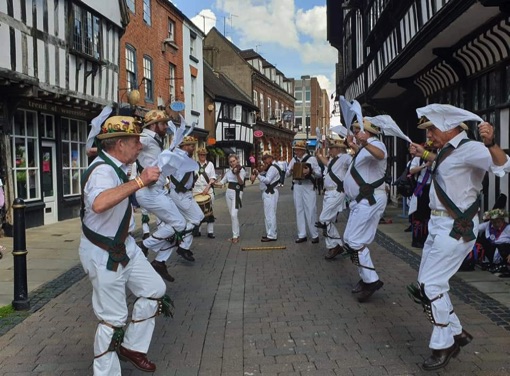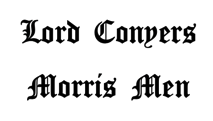

The idea to form a side of Morris Dancers from members of the Kiveton Park Folk Club, which then met at the Lord Conyers Arms in Wales, was conceived at a ceremony to plant an oak tree in the Bluebell Wood beside the road from Kiveton Park to Todwick as a replacement for Robin Hood’s “Trysting Tree” in the spring of 1974. Thenceforth, both the oak tree and Lord Conyers Morris Men have continued to thrive.
By the autumn of that year, a sufficient number of men had expressed an interest and practising began in earnest in early November. By May 1975, the side was ready to give its first public performance, which took place at a ceilidh organised by the Folk Club, on May 2nd. A year later, on 1st May 1976, the custom began of welcoming the star of the Celtic summer by dancing at sunrise (approximately 5.30 am) beside the new “Trysting Tree”.
The first dances learned by Lord Conyers Morris Men were from the Cotswold region of England, the counties of Oxfordshire, Gloucestershire, Northamptonshire and Warwickshire, and these still form the mainstay of our repertoire. To these we soon added dances from Lichfield in Staffordshire and Winster in Derbyshire. Over the years we have gradually added further variants of dancing and customs that come under the general umbrella of Morris.
First we added a Mummers’ Play, based on a script published in Sheffield, which has developed with time and is performed on an irregular basis around Christmas. Next we learned the Abbots Bromley Horn Dance from Staffordshire, which features six men with deer antlers and a number of extra characters. This we perform twice a year in the Bluebell Wood, once on the last Saturday before Christmas Eve and once on the eve of May Day, both performances taking place at dusk.
We first started dancing the “Border Morris” from the West Midland counties as a “one off” for a side member’s wedding. We have since come into possession of manuscripts of dances collected from Bill Scarrott of Pershore, Worcestershire, and currently perform a selection of these throughout the year, although traditionally these would have been danced around mid-winter. Lord Conyers Sword Dance, our own contribution to the Yorkshire tradition of Longsword dancing, came into being in 1987 and can also be seen around mid-winter, as well as at other times of year.
More recently, we have learned two dances from the North West tradition, originating in the Lancashire area. These are noisy, colourful dances performed in clogs, which we dance whenever we have sufficient dancers and a hard surface. And most recently of all, we have spent the last two winters working on the Winlaton dance from the Northumbrian rapper sword tradition, which, when opportunity arises, we dance indoors.
History
